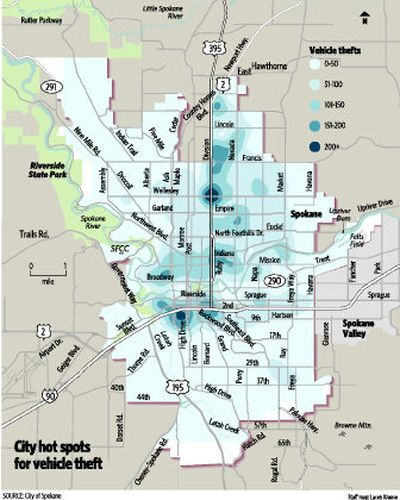Paint vandals leave mark Vandals leave mark

Don’t look now, South Hill, but you’re getting ink done.
Graffiti in 2006 left Spokane looking like a badly tattooed sailor.
And unlike car theft, which was the city’s most reported major crime, incidents of spray painting by vandals registered as problem areas even in the most southern South Hilll neighborhoods.
“The graffiti is absolutely off the hook,” said Brenda Yates, a Spokane Police officer assigned to neighborhoods on the South Hill. “You cannot go anywhere without finding it, and it’s pretty deep south.”
Volunteers from the community oriented policing group, COPS Southwest, say graffiti incidents were neck and neck with car thefts as the neighborhood’s worst problem in 2006. At COPS Southeast, reports of graffiti more than doubled in 2006 to 119, up from 49 a year earlier. Reports of graffiti were lodged as far south as 46th Avenue.
One of the more startling trends is that graffiti incidents seem to be increasing despite cold winter weather, which typically slows down the trend, Yates said. There’s a growing consensus that a communitywide effort is needed to curb the problem before temperatures warm up.
Currently volunteers and police are making the rounds with cameras and paint, photographing graffiti damage so particular vandals can be tracked and then covering up the damage.
In East Central, the graffiti has become so bad, vandals repaint damaged surfaces sometimes within a few hours after things are cleaned up.
“I would say graffiti is probably worse than drugs,” said Lois D’Ewart, a COPS East Central volunteer. “It affects a ton of people, whereas drugs will affect the world around it. Graffiti travels. It’s everywhere.”
D’Ewart has taken 20 graffiti complaints in just the past three weeks. At the current rate, graffiti damage will be reported more than 100 times by the end of March in East Central.
And the local COPS program doesn’t have the volunteers to keep up with the crime, D’Ewart said.
“I need help,” D’Ewart said. “I would like to get volunteers to do nothing but graffiti.”
Auto theft, however, couldn’t be beat., especially on the North Side.
Spokane car thefts have more than doubled in the past eight years and became the city’s most reported crime in 2006, according to the crime statistics.
Car theft reports filed by citizens numbered 2,348 last year. That’s 566 more cars than in 2005. Putting 2006 car thefts in broader perspective, statistics indicate last year was the biggest year-to-year increase since 1999.
Honda Accords and Civics topped the list of cars most stolen. Most of the stolen cars are used for transportation and dumped in another area of the city.
“The bad areas are on the North Side, over by Northtown Mall and Hillyard,” said Cpl. Tom Lee of the Spokane Police Department.
Lee cautions that some of those citizen reports turn out not to be thefts. Spousal breakups, repossessions and cars loaned to acquaintances and returned late sometimes make the list, which isn’t updated after police learn what’s really going on.
Most of the cases are indeed car thefts. City crime mapping reveals three large areas of concern for car theft on the North Side.
In the half-mile radius surrounding the Northtown Mall, the public reported more than 60 vehicles stolen between June and November, but the thefts didn’t let up there. Northward from the mall to the sprawling apartment complexes near Lyons Avenue and Lidgerwood Street, more than 152 cars were reported stolen during the same period.
The mile and a half stretch between Logan and West Central didn’t fare much better. Logan residents reported more than 70 cars stolen from June to November, Emerson Garfield neighbors reported more than 60, as did West Central neighbors.
Similar numbers were reported closer to the Interstate in the Browne’s Addition and Riverside-Cliff Cannon areas.
Police blame much of the increase on “shaved keys,” meaning the keys were originally for another vehicle but were altered by the thief to work in many cars of the same model and similar years.
Spotting a criminal stealing a car with a shaved key can be nearly impossible, as the perpetrator simply walks up to a vehicle, whips out a key to unlock the door, gets inside, starts up the car and drives away. Nail files or grinders are sometimes used to shave down the keys, but police also say thieves have been known to simply work a key’s sharp edges over with a rock.
On a neighborhood by neighborhood level, however, auto theft wasn’t necessarily seen as the biggest problem.
In West Central, drugs were the big concern voiced by members of COPS West. But drugs were also a problem with which the neighborhood has had some success.
“We see it on specific streets, let’s say south of Boone and just very close to the Ash-Maple corridor,” said Carol Ellsworth, a COPS West volunteer. “We oust them from one place, and they relocate to another, sometimes still in our neighborhood.”
Ellsworth’s advice for anyone who thinks they have a drug house in their neighborhood is to start keeping track of the cars that come and go.
Write down license plate numbers as when the cars come and go. The information not only helps police learn who is stopping by for drugs, it also establishes that the home has the kind of traffic commonly associated with drug houses.
COPS East Central volunteer Lois D’Ewart said drugs are a top priority in her neighborhood, which along with West Central was listed as a hot spot for drug activity in 2006.
Police “have shut down a lot of houses and boarded them up,” D’Ewart said. “They shut down one that was right behind on Third, a few blocks away.”